Identifying Ecological Security Patterns Meeting Future Urban Expansion in Changsha–Zhuzhou–Xiangtan Urban Agglomeration, China
Abstract
:1. Introduction
2. Study Area and Data Processing
3. Methodology
3.1. Cellular Automata Modelling
3.2. ESP Identification
3.2.1. Identifying Ecological Resources
- (1)
- Importance of ecological function
- Water conservation
- 2.
- Soil retention
- 3.
- Carbon sequestration
- 4.
- Biodiversity conservation
- (2)
- Eco-environmental sensitivity
- Water contamination
- 2.
- Soil erosion
- 3.
- Soil PH and soil salinity
3.2.2. Constructing the Ecological Resistance of the Surface
3.2.3. Extracting Ecological Corridors and Nodes
4. Results and Analysis
4.1. Land-Use Pattern in 2035
4.2. Spatial Distribution of Ecological Resources
4.2.1. Evaluation of the Importance of Ecological Function
4.2.2. Evaluation of Eco-Environmental Sensitivity
4.2.3. Identification of Ecological Resources
4.3. Spatial Patterns of Resistance Surface, Ecological Corridors, and Ecological Nodes
4.3.1. Spatial Distribution of Surface Ecological Resistance Values
4.3.2. Spatial Patterns of Ecological Corridors and Ecological Nodes
5. Discussion
5.1. Implications of ESP Identification for Urban Development Perspectives
5.2. Limitations and Future Research Directions
6. Conclusions
Author Contributions
Funding
Data Availability Statement
Conflicts of Interest
References
- Hoekstra, A.Y.; Wiedmann, T.O. Humanity’s unsustainable environmental footprint. Science 2014, 344, 1114–1117. [Google Scholar] [CrossRef]
- Liu, X.; Huang, Y.; Xu, X.; Li, X.; Li, X.; Ciais, P.; Lin, P.; Gong, K.; Ziegler, A.D.; Chen, A.; et al. High-spatiotemporal-resolution mapping of global urban change from 1985 to 2015. Nat. Sustain. 2020, 3, 564–570. [Google Scholar] [CrossRef]
- Wang, W.; Jiao, L.; Zhang, W.; Jia, Q.; Su, F.; Xu, G.; Ma, S. Delineating urban growth boundaries under multi-objective and constraints. Sustain. Cities Soc. 2020, 61, 102279. [Google Scholar] [CrossRef]
- Yu, B. Ecological effects of new-type urbanization in China. Renew. Sustain. Energy Rev. 2021, 135, 110239. [Google Scholar] [CrossRef]
- Bren D Amour, C.; Reitsma, F.; Baiocchi, G.; Barthel, S.; Güneralp, B.; Erb, K.; Haberl, H.; Creutzig, F.; Seto, K.C. Future urban land expansion and implications for global croplands. Proc. Natl. Acad. Sci. USA 2017, 114, 8939–8944. [Google Scholar] [CrossRef] [Green Version]
- van Vliet, J. Direct and indirect loss of natural area from urban expansion. Nat. Sustain. 2019, 2, 755–763. [Google Scholar] [CrossRef]
- Ren, Q.; He, C.; Huang, Q.; Shi, P.; Zhang, D.; Güneralp, B. Impacts of urban expansion on natural habitats in global drylands. Nat. Sustain. 2022, 5, 869–878. [Google Scholar] [CrossRef]
- Simkin, R.D.; Seto, K.C.; McDonald, R.I.; Jetz, W. Biodiversity impacts and conservation implications of urban land expansion projected to 2050. Proc. Natl. Acad. Sci. USA 2022, 119, e2117297119. [Google Scholar] [CrossRef]
- Li, G.; Fang, C.; Li, Y.; Wang, Z.; Sun, S.; He, S.; Qi, W.; Bao, C.; Ma, H.; Fan, Y.; et al. Global impacts of future urban expansion on terrestrial vertebrate diversity. Nat. Commun. 2022, 13, 1628. [Google Scholar] [CrossRef]
- Bai, Y.; Wong, C.P.; Jiang, B.; Hughes, A.C.; Wang, M.; Wang, Q. Developing China’s Ecological Redline Policy using ecosystem services assessments for land use planning. Nat. Commun. 2018, 9, 3034. [Google Scholar] [CrossRef] [Green Version]
- Yu, K. Security patterns and surface model in landscape ecological planning. Landsc. Urban Plan. 1996, 36, 1–17. [Google Scholar] [CrossRef]
- Peng, J.; Yang, Y.; Liu, Y.; Hu, Y.; Du, Y.; Meersmans, J.; Qiu, S. Linking ecosystem services and circuit theory to identify ecological security patterns. Sci. Total Environ. 2018, 644, 781–790. [Google Scholar] [CrossRef] [Green Version]
- Peng, J.; Zhao, S.; Dong, J.; Liu, Y.; Meersmans, J.; Li, H.; Wu, J. Applying ant colony algorithm to identify ecological security patterns in megacities. Environ. Modell. Softw. 2019, 117, 214–222. [Google Scholar] [CrossRef] [Green Version]
- Zhang, Y.; Yu, B.; Muhammad Aqeel, A. Ecological security pattern for the landscape of mesoscale and microscale land: A case study of the Harbin city center. J. Environ. Eng. Landsc. 2015, 3, 192–201. [Google Scholar]
- Li, Z.; Li, M.; Xia, B. Spatio-temporal dynamics of ecological security pattern of the Pearl River Delta urban agglomeration based on LUCC simulation. Ecol. Indic. 2020, 114, 106319. [Google Scholar] [CrossRef]
- Wei, Q.; Halike, A.; Yao, K.; Chen, L.; Balati, M. Construction and optimization of ecological security pattern in Ebinur Lake Basin based on MSPA-MCR models. Ecol. Indic. 2022, 138, 108857. [Google Scholar] [CrossRef]
- Jia, Q.; Jiao, L.; Lian, X.; Wang, W. Linking supply-demand balance of ecosystem services to identify ecological security patterns in urban agglomerations. Sustain. Cities Soc. 2023, 92, 104497. [Google Scholar] [CrossRef]
- Rapport, D.J. Ecosystems not optimized: A reply. J. Aquat. Ecosyst. Health 1993, 2, 57. [Google Scholar] [CrossRef]
- Hess, G.R.; Fischer, R.A. Communicating clearly about conservation corridors. Landsc. Urban Plan. 2001, 55, 195–208. [Google Scholar] [CrossRef]
- Cheng, F.; Liu, S.; Hou, X.; Wu, X.; Dong, S.; Ana, C. The effects of urbanization on ecosystem services for biodiversity conservation in southernmost Yunnan Province, Southwest China. J. Geogr. Sci. 2019, 29, 1159–1178. [Google Scholar] [CrossRef] [Green Version]
- Buting, H.; Ping, R.; Quanzhi, Y.; Ling, W. Ecological function regionalization in the Upper Yangtze River. J. Ecol. Rural. Environ. 2019, 35, 1009–1019. (In Chinese) [Google Scholar]
- Wang, Z.; Luo, K.; Zhao, Y.; Lechner, A.M.; Wu, J.; Zhu, Q.; Sha, W.; Wang, Y. Modelling regional ecological security pattern and restoration priorities after long-term intensive open-pit coal mining. Sci. Total Environ. 2022, 835, 155491. [Google Scholar] [CrossRef] [PubMed]
- Lv, L.; Zhang, B.; Xie, X.; Luo, H. China’s energy ecological security impact assessment and policy recommendations. Res. Environ. Sci. 2018, 31, 1819–1826. [Google Scholar]
- Cui, X.; Deng, W.; Yang, J.; Huang, W.; de Vries, W.T. Construction and optimization of ecological security patterns based on social equity perspective: A case study in Wuhan, China. Ecol. Indic. 2022, 136, 108714. [Google Scholar] [CrossRef]
- Ghosh, S.; Das Chatterjee, N.; Dinda, S. Urban ecological security assessment and forecasting using integrated DEMATEL-ANP and CA-Markov models: A case study on Kolkata Metropolitan Area, India. Sustain. Cities Soc. 2021, 68, 102773. [Google Scholar] [CrossRef]
- Hou, W.; Zhou, W.; Li, J.; Li, C. Simulation of the potential impact of urban expansion on regional ecological corridors: A case study of Taiyuan, China. Sustain. Cities Soc. 2022, 83, 103933. [Google Scholar] [CrossRef]
- Qiao, Q.; Zhen, Z.; Liu, L.; Luo, P. The construction of ecological security pattern under rapid urbanization in the Loess Plateau: A case study of Taiyuan city. Remote Sens. 2023, 15, 1523. [Google Scholar] [CrossRef]
- Macmillan, R.A.; Moon, D.E.; Coupé, R.A. Automated predictive ecological mapping in a Forest Region of B.C., Canada, 2001–2005. Geoderma 2007, 140, 353–373. [Google Scholar] [CrossRef]
- Chen, J.; Wang, S.; Zou, Y. Construction of an ecological security pattern based on ecosystem sensitivity and the importance of ecological services: A case study of the Guanzhong Plain urban agglomeration, China. Ecol. Indic. 2022, 136, 108688. [Google Scholar] [CrossRef]
- Wang, Y.; Pan, J. Building ecological security patterns based on ecosystem services value reconstruction in an arid inland basin: A case study in Ganzhou District, NW China. J. Clean. Prod. 2019, 241, 118337. [Google Scholar] [CrossRef]
- Li, S.; Xiao, W.; Zhao, Y.; Lv, X. Incorporating ecological risk index in the multi-process MCRE model to optimize the ecological security pattern in a semi-arid area with intensive coal mining: A case study in northern China. J. Clean. Prod. 2020, 247, 119143. [Google Scholar] [CrossRef]
- Lin, L.; Wei, X.; Luo, P.; Wang, S.; Kong, D.; Yang, J. Ecological security patterns at different spatial scales on the Loess Plateau. Remote Sens. 2023, 15, 1011. [Google Scholar] [CrossRef]
- Peng, J.; Guo, X.; Hu, Y.; Liu, Y. Constructing ecological security patterns in mountain areas based on geological disaster sensitivity: A case study in Yuxi city, Yunnan province, China. Chin. J. Appl. Ecol. 2017, 28, 627–635. (In Chinese) [Google Scholar]
- Wei, H.; Zhu, H.; Chen, J.; Jiao, H.; Li, P.; Xiong, L. Construction and optimization of ecological security pattern in the Loess Plateau of China based on the Minimum Cumulative Resistance (MCR) model. Remote Sens. 2022, 14, 5906. [Google Scholar] [CrossRef]
- Gurrutxaga, M.; Lozano, P.J.; Del Barrio, G. GIS-based approach for incorporating the connectivity of ecological networks into regional planning. J. Nat. Conserv. 2010, 18, 318–326. [Google Scholar] [CrossRef]
- Yang, Y.; Feng, Z.; Wu, K.; Lin, Q. How to construct a coordinated ecological network at different levels: A case from Ningbo city, China. Ecol. Inform. 2022, 70, 101742. [Google Scholar] [CrossRef]
- Li, Y.; Lin, J.; Su, X. An early warning method on ecological risk and its application to improve landscape ecological security pattern regulation. Geogr. Res. 2017, 36, 485–494. (In Chinese) [Google Scholar]
- Dai, L.; Liu, Y.; Luo, X. Integrating the MCR and DOI models to construct an ecological security network for the urban agglomeration around Poyang Lake, China. Sci. Total Environ. 2020, 754, 141868. [Google Scholar] [CrossRef]
- Mcrae, B.H.; Beier, P. Circuit theory predicts gene flow in plant and animal populations. Proc. Natl. Acad. Sci. USA 2007, 104, 19885–19890. [Google Scholar] [CrossRef] [Green Version]
- An, Y.; Liu, S.; Sun, Y.; Shi, F.; Beazley, R. Construction and optimization of an ecological network based on morphological spatial pattern analysis and circuit theory. Landsc. Ecol. 2021, 36, 2059–2076. [Google Scholar] [CrossRef]
- Zhang, Y.; Zhao, Z.; Fu, B.; Ma, R.; Yang, Y.; Lv, Y.; Wu, X. Identifying ecological security patterns based on the supply, demand and sensitivity of ecosystem service: A case study in the Yellow River Basin, China. J. Environ. Manag. 2022, 315, 115158. [Google Scholar] [CrossRef] [PubMed]
- Fan, F.; Wen, X.; Feng, Z.; Gao, Y.; Li, W. Optimizing urban ecological space based on the scenario of ecological security patterns: The case of central Wuhan, China. Appl. Geogr. 2022, 138, 102619. [Google Scholar] [CrossRef]
- Saura, S.; Pascual-Hortal, L. A new habitat availability index to integrate connectivity in landscape conservation planning: Comparison with existing indices and application to a case study. Landsc. Urban Plan. 2007, 83, 91–103. [Google Scholar] [CrossRef]
- Li, L.; Huang, X.; Wu, D.; Yang, H. Construction of ecological security pattern adapting to future land use change in Pearl River Delta, China. Appl. Geogr. 2023, 154, 102946. [Google Scholar] [CrossRef]
- Li, Y.; Liu, W.; Feng, Q.; Zhu, M.; Yang, L.; Zhang, J.; Yin, X. The role of land use change in affecting ecosystem services and the ecological security pattern of the Hexi Regions, Northwest China. Sci. Total Environ. 2023, 855, 158940. [Google Scholar] [CrossRef]
- Liu, X.; Liang, X.; Li, X.; Xu, X.; Ou, J.; Chen, Y.; Li, S.; Wang, S.; Pei, F. A future land use simulation model (FLUS) for simulating multiple land use scenarios by coupling human and natural effects. Landsc. Urban Plan. 2017, 168, 94–116. [Google Scholar] [CrossRef]
- Wang, W.; Jiao, L.; Dong, T.; Xu, Z.; Xu, G. Simulating urban dynamics by coupling top-down and bottom-up strategies. Int. J. Geogr. Inf. Sci. 2019, 33, 2259–2283. [Google Scholar] [CrossRef]
- Hu, J.; Yan, D.; Wang, W. Estimating carbon stock change caused by multi-scenario land-use structure in Urban Agglomeration. Sustainability 2023, 15, 5503. [Google Scholar] [CrossRef]
- Wang, W.; Jiao, L.; Jia, Q.; Liu, J.; Mao, W.; Xu, Z.; Li, W. Land use optimization modelling with ecological priority perspective for large-scale spatial planning. Sustain. Cities Soc. 2021, 65, 102575. [Google Scholar] [CrossRef]
- Liang, X.; Guan, Q.; Clarke, K.C.; Liu, S.; Wang, B.; Yao, Y. Understanding the drivers of sustainable land expansion using a patch-generating land use simulation (PLUS) model: A case study in Wuhan, China. Comput. Environ. Urban Syst. 2021, 85, 101569. [Google Scholar] [CrossRef]
- Liang, X.; Guan, Q.; Clarke, K.C.; Chen, G.; Guo, S.; Yao, Y. Mixed-cell cellular automata: A new approach for simulating the spatio-temporal dynamics of mixed land use structures. Landsc. Urban Plan. 2021, 205, 103960. [Google Scholar] [CrossRef]
- MEP. Guidelines for the Delineation of Ecological Protection Red Lines (MEP No. 56, 2015). 2015. Available online: https://www.mee.gov.cn/gkml/hbb/bwj/201505/W020150519635317083395.pdf (accessed on 30 May 2015). (In Chinese)
- China’s State Council. Several Opinions on Establishing Territorial Spatial Planning System and Supervising for Implementation. 2019. Available online: http://www.gov.cn/zhengce/2019-05/23/content_5394187.htm (accessed on 23 May 2019). (In Chinese)
- Department of Natural Resources of Hunan Province. Technical Guide for Evaluation of Resource and Environment Carrying and Territory Spatial Development Suitability in Hunan. 2019. Available online: https://www.ciyew.com/spatial_planning/3047-3521.html (accessed on 30 April 2019). (In Chinese)
- Yang, J.; Huang, X. The 30 m annual land cover dataset and its dynamics in China from 1990 to 2019. Earth Syst. Sci Data 2021, 13, 3907–3925. [Google Scholar] [CrossRef]
- Chen, Y.; Li, X.; Liu, X.; Ai, B. Modeling urban land-use dynamics in a fast developing city using the modified logistic cellular automaton with a patch-based simulation strategy. Int. J. Geogr. Inf. Sci. 2014, 28, 234–255. [Google Scholar] [CrossRef]
- Xing, W.; Qian, Y.; Guan, X.; Yang, T.; Wu, H. A novel cellular automata model integrated with deep learning for dynamic spatio-temporal land use change simulation. Comput. Geosci. 2020, 137, 104430. [Google Scholar] [CrossRef]
- Li, X.; Gar-Onyeh, A. Neural-network-based cellular automata for simulating multiple land use changes using GIS. Int. J. Geogr. Inf. Sci. 2002, 16, 323–343. [Google Scholar] [CrossRef]
- Wang, W.; Ye, L.; Yang, K.; Wang, G.; Su, F. Analysis on spatial characteristics of soil erosion in Erhai river basin based on GIS and RUSLE. Hubei Agric. Sci. 2015, 54, 6. (In Chinese) [Google Scholar]
- Zhong, J.; Liu, J.; Jiao, L.; Lian, X.; Xu, Z.; Zhou, Z. Assessing the comprehensive impacts of different urbanization process on vegetation net primary productivity in Wuhan, China, from 1990 to 2020. Sustain. Cities Soc. 2021, 75, 103295. [Google Scholar] [CrossRef]
- Wang, H.; Ma, X.; Du, Y. Constructing ecological security patterns based on ecological service importance and ecological sensitivity in Guangdong. Acta Ecol. Sin. 2021, 41, 1705–1715. (In Chinese) [Google Scholar]
- Li, Q.; Zhou, Y.; Yi, S. An integrated approach to constructing ecological security patterns and identifying ecological restoration and protection areas: A case study of Jingmen, China. Ecol. Indic. 2022, 137, 108723. [Google Scholar] [CrossRef]
- Ouyang, X.; Xu, J.; Li, J.; Wei, X.; Li, Y. Land space optimization of urban-agriculture-ecological functions in the Changsha-Zhuzhou-Xiangtan Urban Agglomeration, China. Land Use Policy 2022, 117, 106112. [Google Scholar] [CrossRef]
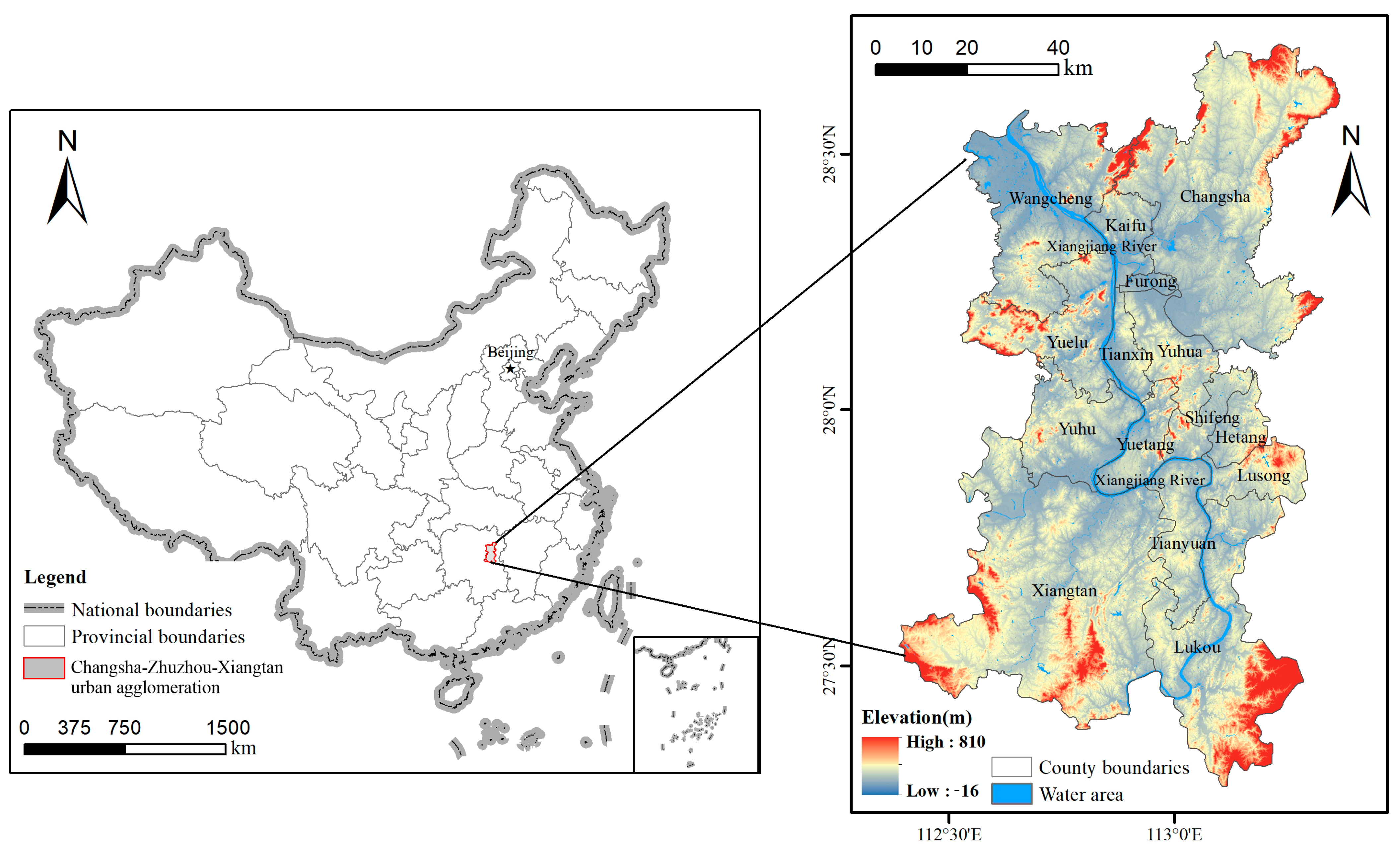
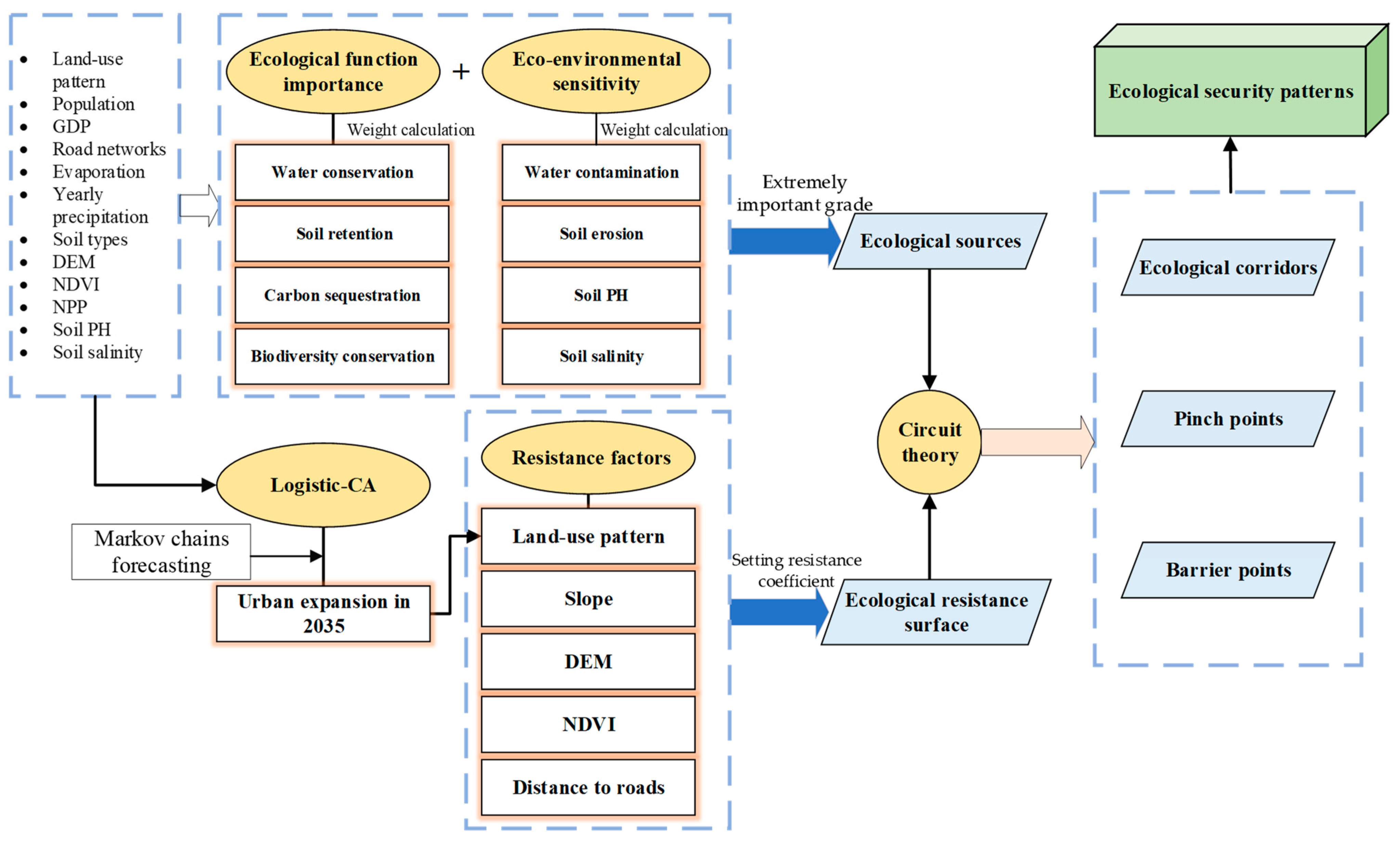
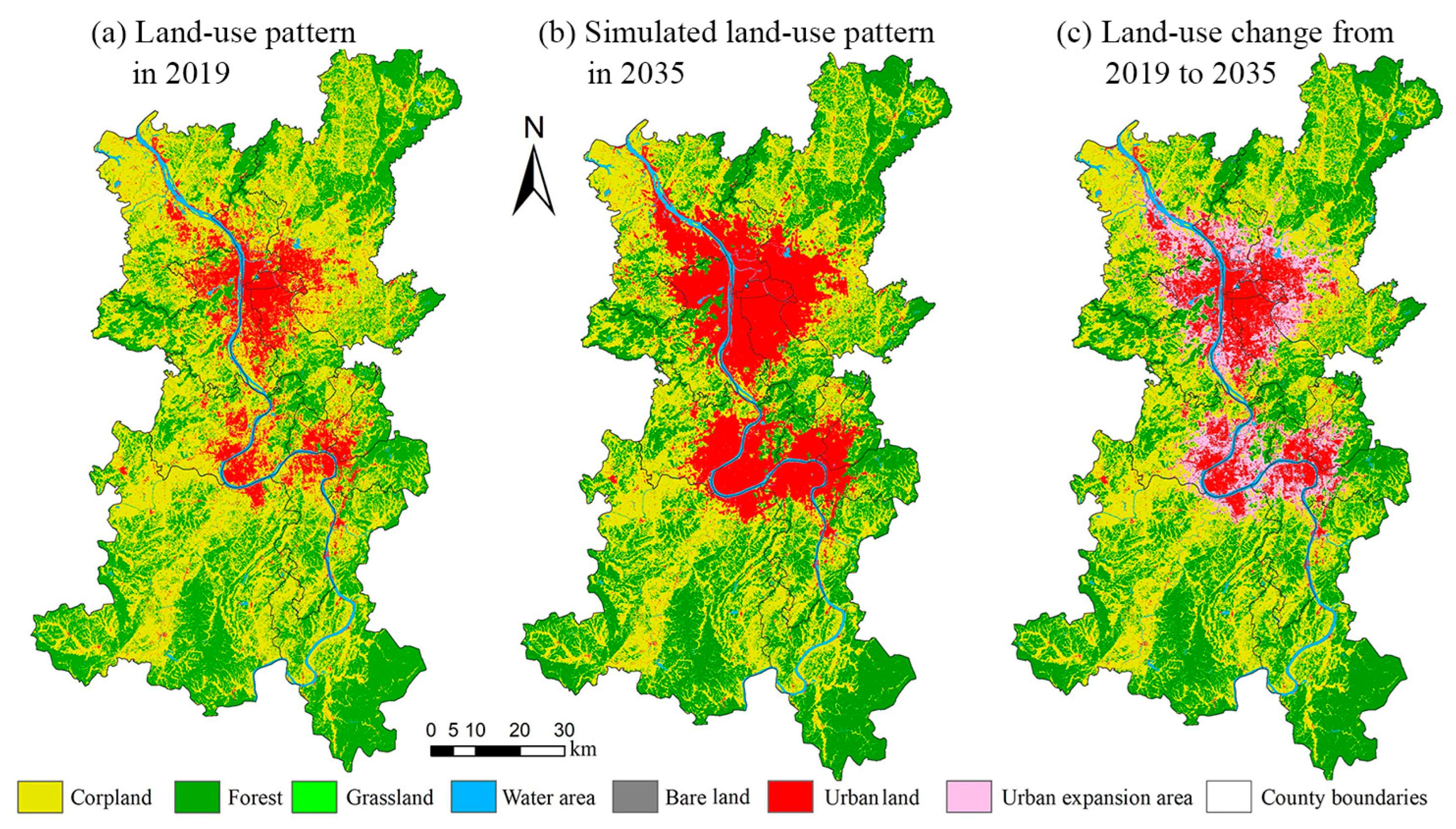


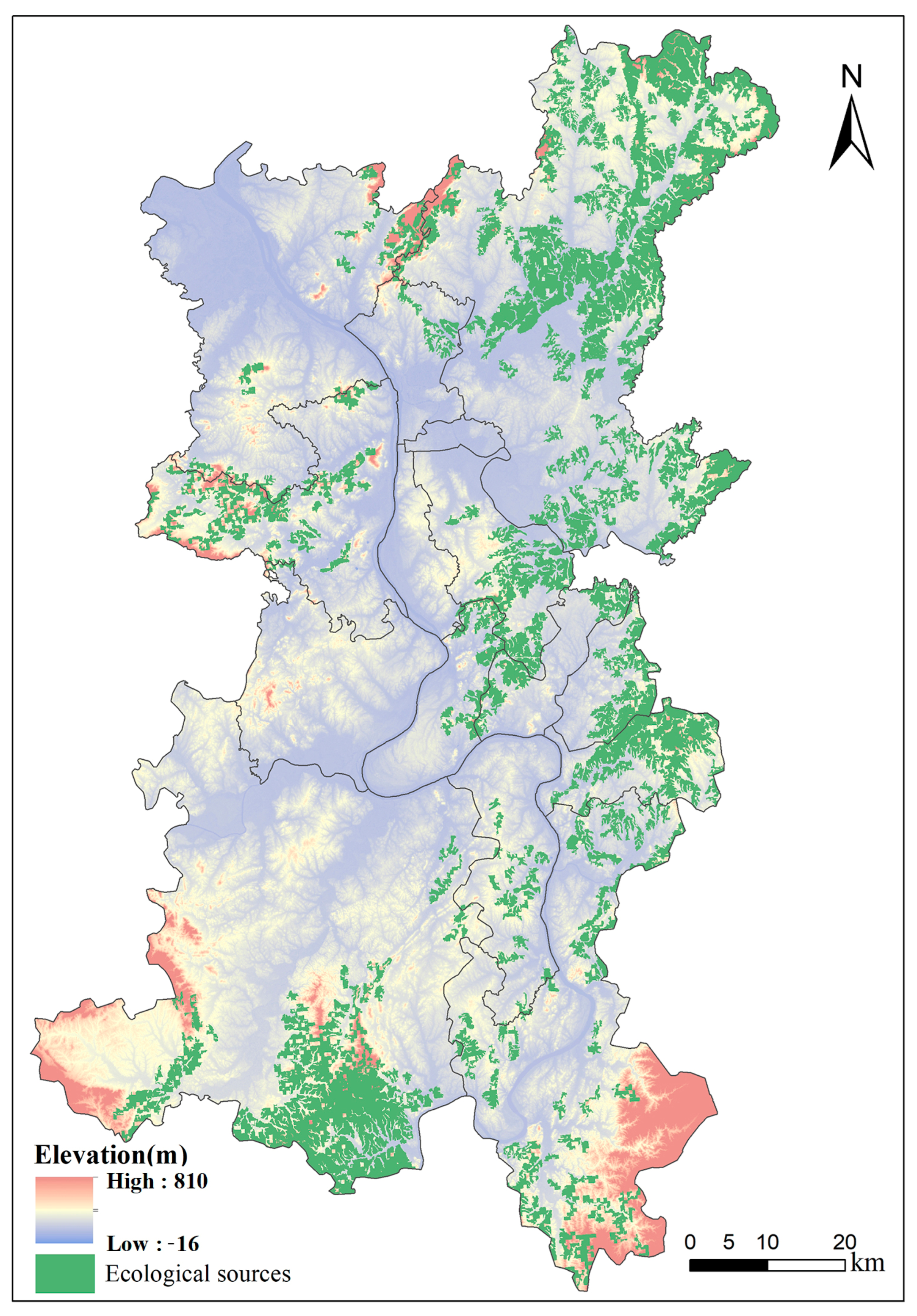
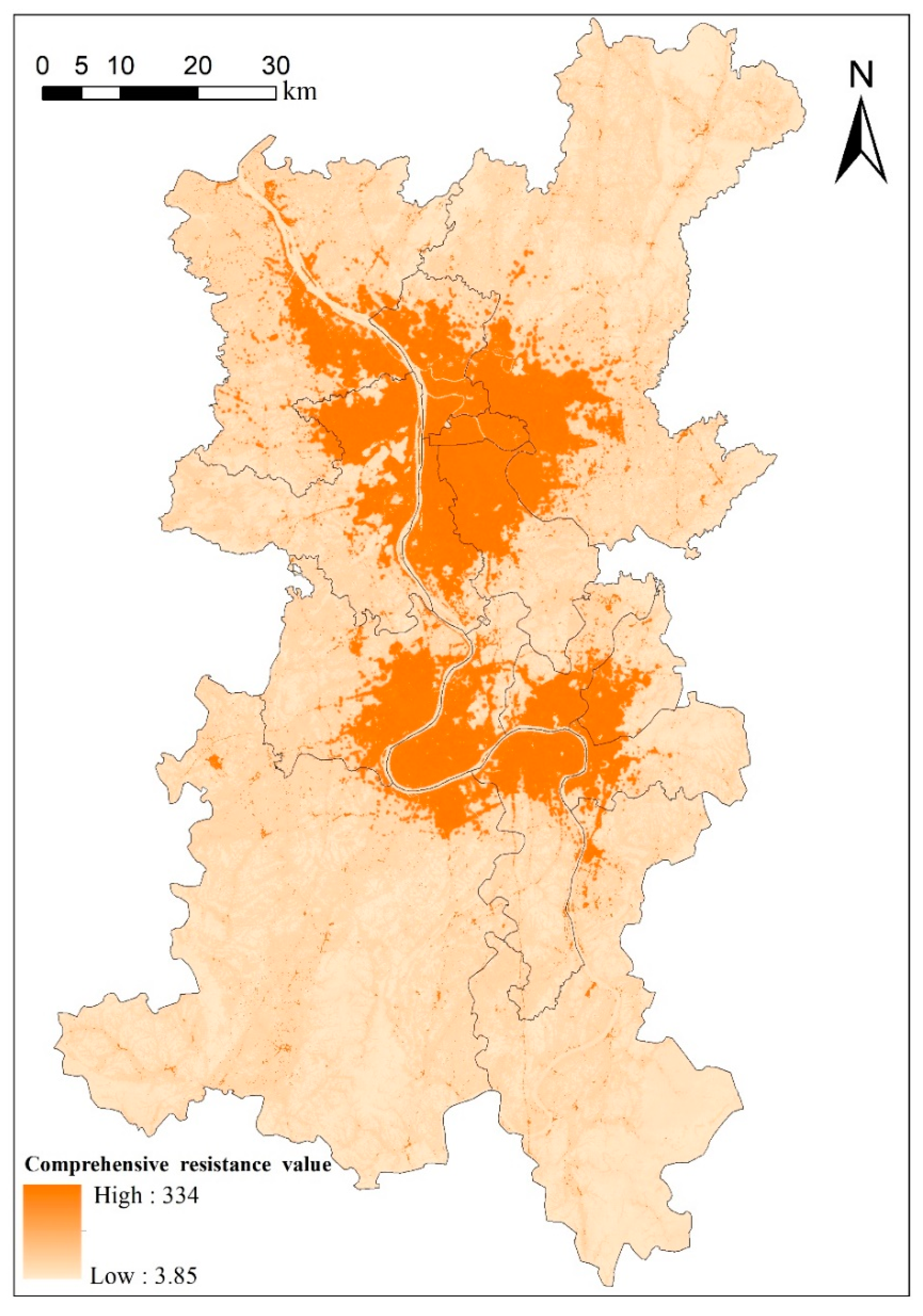

| Data Types | Spatial Scale | Data Sources |
|---|---|---|
| Land-use pattern (2000, 2010, 2015, and 2019) | 30 m | Derived from Yang [55] (https://zenodo.org/record/5816591#.YvueF8iVX04 (accessed on 9 August 2022)) |
| Population (2010) | 1 km | Resource and Environment Data Cloud Platform (http://www.resdc.cn/ (accessed on 2 August 2003)) |
| GDP (2010) | 1 km | |
| Road networks (2010) | 1:100,000 | Open-street Map (www.openstreetmap.org/ (accessed on 1 July 2004)) |
| Evaporation (ET) (2010 and 2019) | 1 km | National Science & Technology Infrastructure (http://www.cnern.org.cn/ (accessed on 1 July 2019)) |
| Yearly precipitation (2010 and 2019) | N/A | National meteorological science data center (http://data.cma.cn/ (accessed on 29 September 2015)) |
| Soil types (2019) | 1:1,000,000 | Geographic Data Sharing Infrastructure, College of Urban and Environmental Science, Peking University (http://geodata.pku.edu.cn (accessed on 25 December 2018)) |
| Digital elevation model (DEM) (2009) | 30 m | Geospatial Data Cloud (http://www.gscloud.cn/ (accessed on 20 December 210)) |
| Normalized difference vegetation index (NDVI) (2010 and 2019) | 1 km | |
| Net primary productivity (NPP) (2010 and 2019) | 500 m | Derived from Google Earth Engine (GEE) (https://earthengine.google.com/ (accessed on 25 December 2017)) |
| Soil PH (1995~2011) | N/A | National Science & Technology Infrastructure (http://www.cnern.org.cn/data/meta?id=40176 (accessed on 1 July 2019)) |
| Soil salinity (1995~2011) | ||
| Administrative boundaries (2019) | 1:100,000 | Geospatial Data Cloud (http://www.gscloud.cn/ (accessed on 20 December 210)) |
| Resistance Indicator | Classification | Resistance Value | Weight | Resistance Indicator | Classification | Resistance Value | Weight |
|---|---|---|---|---|---|---|---|
| Land-use types | Forest land | 1 | 0.4 | Distance to roads | [0, 200] | 100 | 0.15 |
| Water bodies | 10 | (200, 400] | 80 | ||||
| Grassland | 30 | (400, 800] | 60 | ||||
| Bare land | 50 | (800, 1600] | 40 | ||||
| Cropland | 100 | (1600, 3200] | 20 | ||||
| Urban land | 700 | (3200, +∞) | 1 | ||||
| Slope | [0, 6] | 1 | 0.15 | DEM | [0, 25] | 1 | 0.15 |
| (6, 15] | 40 | (25, 50] | 40 | ||||
| (15, 25] | 60 | (50, 100] | 60 | ||||
| (25, 35] | 80 | (100, 300] | 80 | ||||
| (35, 90] | 100 | (300, +∞) | 100 | ||||
| [0, 0.3] | 100 | ||||||
| (0.3, 0.5] | 80 | ||||||
| NDVI | (0.5, 0.65] | 60 | 0.15 | ||||
| (0.65, 0.75] | 40 | ||||||
| (0.75, 1] | 1 |
| District/County | Urban Built-Up Areas (2019) | Urban Built-Up Areas (2035) | Newly-Added Urban Areas |
|---|---|---|---|
| Furong | 33.85 | 41.16 | 7.31 |
| Tianxin | 57.78 | 88.03 | 30.25 |
| Yuelu | 89.54 | 146.04 | 56.50 |
| Kaifu | 56.68 | 105.79 | 49.11 |
| Yuhua | 86.93 | 116.67 | 29.74 |
| Wangcheng | 69.81 | 138.04 | 68.23 |
| Changsha county | 109.96 | 209.74 | 99.78 |
| Hetang | 26.95 | 48.87 | 21.92 |
| Lusong | 18.17 | 37.11 | 18.93 |
| Shifeng | 36.99 | 55.90 | 18.91 |
| Tianyuan | 47.40 | 86.74 | 39.34 |
| Lukou | 17.40 | 19.47 | 2.07 |
| Yuhu | 59.12 | 114.49 | 55.36 |
| Yuetang | 59.56 | 113.97 | 54.41 |
| Xiangtan county | 41.66 | 66.40 | 24.74 |
| Overall | 811.83 | 1388.45 | 576.62 |
Disclaimer/Publisher’s Note: The statements, opinions and data contained in all publications are solely those of the individual author(s) and contributor(s) and not of MDPI and/or the editor(s). MDPI and/or the editor(s) disclaim responsibility for any injury to people or property resulting from any ideas, methods, instructions or products referred to in the content. |
© 2023 by the authors. Licensee MDPI, Basel, Switzerland. This article is an open access article distributed under the terms and conditions of the Creative Commons Attribution (CC BY) license (https://creativecommons.org/licenses/by/4.0/).
Share and Cite
Wang, W.; Li, B.; Su, F.; Jiang, Z.; Chen, S. Identifying Ecological Security Patterns Meeting Future Urban Expansion in Changsha–Zhuzhou–Xiangtan Urban Agglomeration, China. Remote Sens. 2023, 15, 3141. https://doi.org/10.3390/rs15123141
Wang W, Li B, Su F, Jiang Z, Chen S. Identifying Ecological Security Patterns Meeting Future Urban Expansion in Changsha–Zhuzhou–Xiangtan Urban Agglomeration, China. Remote Sensing. 2023; 15(12):3141. https://doi.org/10.3390/rs15123141
Chicago/Turabian StyleWang, Weilin, Bin Li, Fei Su, Zhenfeng Jiang, and Shulu Chen. 2023. "Identifying Ecological Security Patterns Meeting Future Urban Expansion in Changsha–Zhuzhou–Xiangtan Urban Agglomeration, China" Remote Sensing 15, no. 12: 3141. https://doi.org/10.3390/rs15123141






